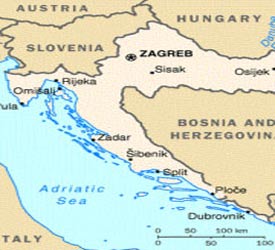Information
Whether as part of annexed or independent Croatia, Zagreb has always been the focal point and heart of the Croat population. The importance of the city has, throughout centuries of foreign rule, been recognised for its cultural, religious and commercial influence within the region and much of this is still reflected in Zagreb today. As a stop over point for travellers passing from East to West (or vice-versa), or for the increasing number of tourists travelling towards Adriatic Sea resorts, Zagreb is changing. And it is changing to reflect, not just the needs of travellers, but also according the desires of an increasing ambitious population who seeking to open up a new, optimistic chapter of Croatian history after the painful events of the 20th century.
First recognition of the settlement as Zagreb appears to have been recorded in 1094, although the origins of the name Zagreb are less clear. Popular Croatian legend suggests that, while crossing a deserted region with his thirsty troops, a Croatian ban or viceroy drove his sabre into the ground through sheer frustration at his plight and, on doing so, inadvertedly uncovered a source of water, saving the day for both himself and his troops. The ban immediately ordered the troops to scrape the soil in order to uncover the water, and the name Zagreb comes from the Croatian verb to scrape. The idea of digging or unearthing is supported by scientists who suggest that the settlement was established beyond a water-filled hole or 'graba' and that the name derives from this. Others suggest that the name derives from the term 'za breg' or beyond the hill. The hill may well have been the river bank of the River Sava, which is believed to have previously flowed closer to the city centre. From here, the words may have been fused into one word and, thus, the name Zagreb was born.
The cultural and older part of modern-day Zagreb is actually based around two ancient hill communities, those of Kaptol and Gradec. Hungarian King Ladislaus founded a bishopric in Kaptol in 1094, and then, following the departure in the 13th century of the Mongols, King Bela IV declared Gradec to be a royal autonomous city as a means of attracting foreign artisans. These honours and awards sparked competition and rivalry with the two communities constantly endeavouring to outdo each other both politically and commercially. It was not until the 17th century that the two entities merged to form Zagreb. Though this area remains the cultural heart of the city and the bishopric in Kaptol has been upgraded to archbishopric status, development since the 18th century has seen most of the commercial activity shift to the southern expansion of the city.
The introduction of the railroad to Zagreb in the 19th century was a key factor in the development of todays Zagreb. The addition of Zagreb to the Oriental Express schedule was influential in the construction of opulent buildings such as the Regent Esplanade, constructed to cater for the foreign rich who now stopped regularly in Zagreb on their way to Istanbul. In addition, the opening of the route through to Istanbul meant that Zagreb was now at the centre of the main East-West trade route, as well as the traditional established route between Austria and Hungary. The building of the railroad also allowed older suburbs to be naturally incorporated into the city centre and provided ready-made locations for further expansion to take place. Most of this development took place between the railway and the Sava River, the most intensive period of which came after World War II. With Yugoslavias accession to the league of Communist countries, expansion of Zagreb spilled south of the Sava River; an area now known as Novi Zagreb (New Zagreb) was born, and expansion continued to the east and west, absorbing several suburbs along the way.
On declaring independence from Yugoslavia on June 25th 1991, Zagreb was officially declared the capital of Croatia. Though for some time Zagreb was considered a Croatian stronghold and eventual target of the Serb/Yugoslavian insurgent forces, fortunately for the city and its residents very little conflict was actually experienced. Today, Zagreb is the only Croatian city whose metropolitan population exceeds one million. The vast majority of Zagrebs residents consider themselves to be Croats; of the many other ethnic minorities, Serbs are the most significant.
 Population: 4.5 million
Capital: Zagreb
Major language: Croatian
Major religion: Catholic (88%)
Life expectancy: 71 years (men), 78.5 years (women)
Monetary unit: 1 Kuna (HRK) = 100 Lipa
Main exports: Transport equipment, textiles, chemicals, foodstuffs, fuels.
Average annual income: US $8,750 (Jan 2005)
Internet domain: .hr
International dialing code: +385
Population: 4.5 million
Capital: Zagreb
Major language: Croatian
Major religion: Catholic (88%)
Life expectancy: 71 years (men), 78.5 years (women)
Monetary unit: 1 Kuna (HRK) = 100 Lipa
Main exports: Transport equipment, textiles, chemicals, foodstuffs, fuels.
Average annual income: US $8,750 (Jan 2005)
Internet domain: .hr
International dialing code: +385
About Zagreb
Croatia, or Hrvatska as it is known by the locals, has in some form or another existed since the 7th Century, when the Croats first settled in the provinces of Dalmatia and Pannonia. Though at times ruled by the Eastern Romans and the Franks, Croatia had developed into a strong independent kingdom by 925 and remained autonomous until 1102, when internal struggles forced the kingdom into a dynastic alliance with Hungary, thus allowing Croatia to retain its system of viceroys (bans) and for the nobility to retain their lands and titles.
Hungarian rule held firm until the mid 1400s, when, in the face of increasing Ottoman expansion, several regions were taken over either by foreign forces or became independent states. The marriage of Hungarian ruler Luis II to Maria of Austria, in 1522, drew Hungary (and what remained of Hungarian-controlled Croatia) closer to the Hapsburg kingdom, which in turn prompted the Ottomans to attack Hungary in a bid to expand the Empires territory. This attack in 1526 was known as the Battle of the Mohacs and resulted in the end of the independent kingdom of Hungary. In a bid to protect what was left of Croatia, parliament elected to accept the Hapsburgs as the rightful rulers of Croatia and thus proved successful in repelling further Ottoman advances. By the 18th century, much of the territory lost to the Ottomans had been reclaimed and by 1815, the provinces of Istria, Dalmatia and Dubrovnik had all been successfully integrated into the Hapsburg monarchy.
Following World War I, Croatia joined the State of the Slovenes covering what is modern day Croatia, Slovenia and Bosnia. Soon afterwards, this was united with Serbia to form the Kingdom of Serbs, Croats and Slovenes which, in 1929, became known as Yugoslavia.
In 1941, Yugoslavia came under Nazi attack and Croatia, siding with the Nazis and Fascist Italy, declared itself to be an independent state. This resulted in a three-sided civil war that lasted until May 1945. The Axis-supported Ustasa army seized control of the country and went about attempting to compartmentalise and cleanse the population of the newly declared state, using an adapted-for-Croatia version of the Nazi ideology towards race. A series of laws aimed at maintaining Croatian and Aryan racial superiority were quickly passed during 1941 along with the establishment of various ruling committees. Before long, prisons were overflowing with the ever-increasing number of inmates and, in July, the first Croatian concentration camp was opened in Jasenovac. Eventually concentration camps would be opened in eleven other locations, though the complex at Jasenovac was by far the biggest and is considered to have been the third largest used during World War II. Nazi policy to exterminate Jews, gypsies and Communists was modified to fit the Ustasas desire to incorporate Serbs into this plan of mass eradication. As in other Axis-controlled countries, much of the intelligentsia was systematically wiped out in a bid for political control and to diminish the possibility of uprising.
By the end of 1942, news of the Ustasas atrocities had become common knowledge and much of the population became increasingly disillusioned with the Croatian rule and began to lend its support to Titos Communist forces and the Chetniks, a Serbian royalist group. Though some pockets of Ustasa forces continued to fight after Germanys defeat, by the end of May 1945 the Independent State of Croatia effectively ceased to exist. The advance of General Titos forces, backed by the Soviet Red Army, resulted in the mass retreat and fleeing of the remaining Ustasa forces.
On November 29, 1945 the Socialist Ferderal Republic of Yugoslavia was established and soon after six constituent republics were created, one of which was the Socialist Republic of Croatia, with Zagreb as its capital. Tito was elected prime minister in 1953 and later in 1974 was named President for Life. Throughout his reign as leader of Yugoslavia, Tito caused the Soviet Union much consternation with his refusal to follow the Moscow line and, after years of tumultuous relations, the SFRY was expelled from the World Communist League.
Titos death in 1980 began the process of dissolution within the SFRY as ethnic groups and republics seeking greater autonomy and independence. Titos strong leadership skills and ability to transcend ethnic conflicts were lost and with them perhaps any long term hope of the survival of the SFRY in its existing state.
In 1990, at the 14th Congress of Yugoslav Communists, the party dissolved along national lines and the Croatian Communists left the congress. In 1991, Croatia declared itself independent from Yugoslavia and thus began the Croatian War of Independence between Croats and the Yugoslav-backed Serbs. The Vance peace plan, designating four UNPA zones for Serbs, brought an end to large-scale military conflict between the Croats and Serbs and resulted in Croatia being internationally recognised as an independent nation.
Further territorial conflict and inter-ethnic violence continued on a smaller scale until December 1995 when the Dayton Agreement was signed, bringing an end to war in Bosnia and Herzegovina and signalling a new period of border and independence recognition in the region. This also resulted in the Federal Republic of Yugoslavias recognition of Croatias independence.
Today, Croatia is moving ever closer to accession to the EU. Granted official candidate status in 2004, it is expected that Croatia will join the EU shortly after 2010, thereby making it the second (after Slovenia) of the former Yugoslav bloc countries to gain entry. After a few years of economic instability during the difficult period of transition, Croatia now has a stable market economy and better statistical indicators than many of the countries who joined the EU in 2004. Increasing numbers of visitors to Croatia and an improving economy is reflected in an ever-improving infrastructure system, and an increasing number of high-end commercial outlets ready to cater to a wealthier population and foreign visitors. It appears that Croatia is finally ready to leave years of conflict, bloodshed and economic stagnation firmly in the past and enter a new era as part of modern Europe.
